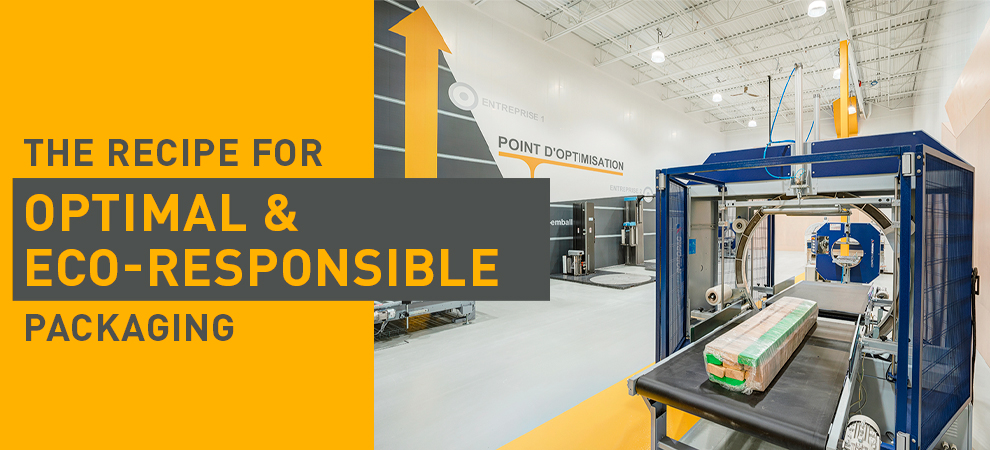
The recipe for optimal and eco-responsible packaging!
Did you know that 51% of consumers consider their packages to be overpacked? However, 20% of merchandise returns are damaged products, which suggests that many of these packages were not adequately protected during transport and delivery. There is therefore a very fine line between over-packaged or under-packaged merchandise and optimal packaging! In this context, is it possible to have both a suitably packaged parcel and an eco-responsible packaging?
IN SEARCH OF A BALANCE BETWEEN OVERPACKING AND UNDERPACKING

An overwrapped product is far from being eco-responsible and profitable, since many materials are used in excess, inadequately or unnecessarily. Who hasn’t already sighed when they received a huge box full of paper or air bags for a small item ordered online? This situation is unfortunately very widespread – even in a professional context.
For your logistics packaging solutions, ask yourself if pallets with non-slip sheets and angles are really useful. Or maybe it’s the stretch wrap that just isn’t well chosen or applied?

Receiving a damaged or broken product is quite frustrating, and an under-packed parcel is much more likely to reach its destination damaged.
In addition to annoying your customers, this situation creates significant costs for your company, which must then start the entire extremely expensive process of manufacturing and delivering all over again. A catastrophic scenario for the environment!

According to CITEO, packaging represents 10% of the pollution emitted in the life cycle of a commodity when considering the packaging-product pair. The remaining 90% of greenhouse gas (GHG) emissions relate to its production, transport and delivery.
A poorly packaged parcel therefore creates the most damage to our environment! The unhappy customer will effectively make a return or exchange (more shipping!), And the life cycle of a new product will start all over again.
For this reason, eliminating plastic from your packaging or, even, opting for 100% recyclable or recycled products is not necessarily the most eco-responsible recipe. On one hand, plastic can play a crucial protective role and, on the other hand, recyclable packaging can have reliability gaps. In other words, just because the products used are perceived as “eco-responsible” does not mean that the solution will be optimal for the environment. Above all, a green solution must adequately protect the goods!
OPTIMIZE YOUR PACKAGING IN TWO STEPS
To find the perfect match between efficient and eco-responsible packaging, the experts in our optimization laboratory usually target two factors: the volume or the number of components.

Decrease the volume
We know that optimal packaging should not contain more than 15% empty space. However, a recent Forbes study shows that almost 25% of the goods transported are composed of air. In other words, a quarter of the trucks on the road are currently carrying air! GHGs are therefore emitted to transport vacuum because loads are not optimized from a volumetric point of view. This is the importance of a good packaging recipe, in order to limit the costs of packaging, transport, storage and delivery with minimal impact on the environment.

Reduce the number of components
In order to design the packaging solution that meets your needs and uses as few elements as possible, you first need to determine the purpose of each of these components, test them, and then evaluate their performance. Then you have to find the optimal combination, using the bare minimum and having maximum efficiency. Good thing, this has been our laboratory’s goal since 2011.

To concretely compare the ecological footprint of two packaging recipes, we use cutting-edge software based on the following criteria:
- Location of manufacturer
- Location of end user
- Carbon footprint
- Total energy consumed
- Air acidification
- Water eutrophication
We get an accurate picture of the environmental impact of the initial and proposed packaging solutions. With this data, our experts can therefore design new recipes, in particular reducing GHGs by up to 28% while maintaining optimal packaging.

Several ingredients come into play in eco-responsible packaging. Sometimes plastic is the best solution; in other cases, cardboard is best. The important thing is to protect the package! Each suitable packaging therefore contributes to preserving the environment by limiting damage caused by transport and avoiding duplicating the manufacturing process of a damaged item.
One thing is certain, if completely eliminating packaging from our lives is not possible (for the moment!), Developing the optimal recipe becomes the best eco-responsible option!
The Cartier team also suggests
Laboratory
Categories: Écoresponsabilité, Laboratory
Customer examples that speak for themselves!
In addition to responding to different requests and constraints, our team is committed to always keeping eco-responsibility in mind, enabling our customers to reduce their components, their costs and their GHGs – yes, their GHGs!
Laboratory
Categories: Laboratory, Témoignages
The Rotec International success story
The synergy between Rotec and CARTIER has been nothing short of transformative. Together, we embarked on an innovative project, aligning our expertise and ambition to set new industry benchmarks.
Laboratory
Categories: E-commerce, Écoresponsabilité, Laboratory
Possible subsidies for eco-responsible projects; It’s this way!
2023 is definitely the year we want to make a mark with our serious and unprecedented commitment to environmental responsibility. The proof? Our inclusion as an eco-design expert in the Ecoleader Fund directory!




